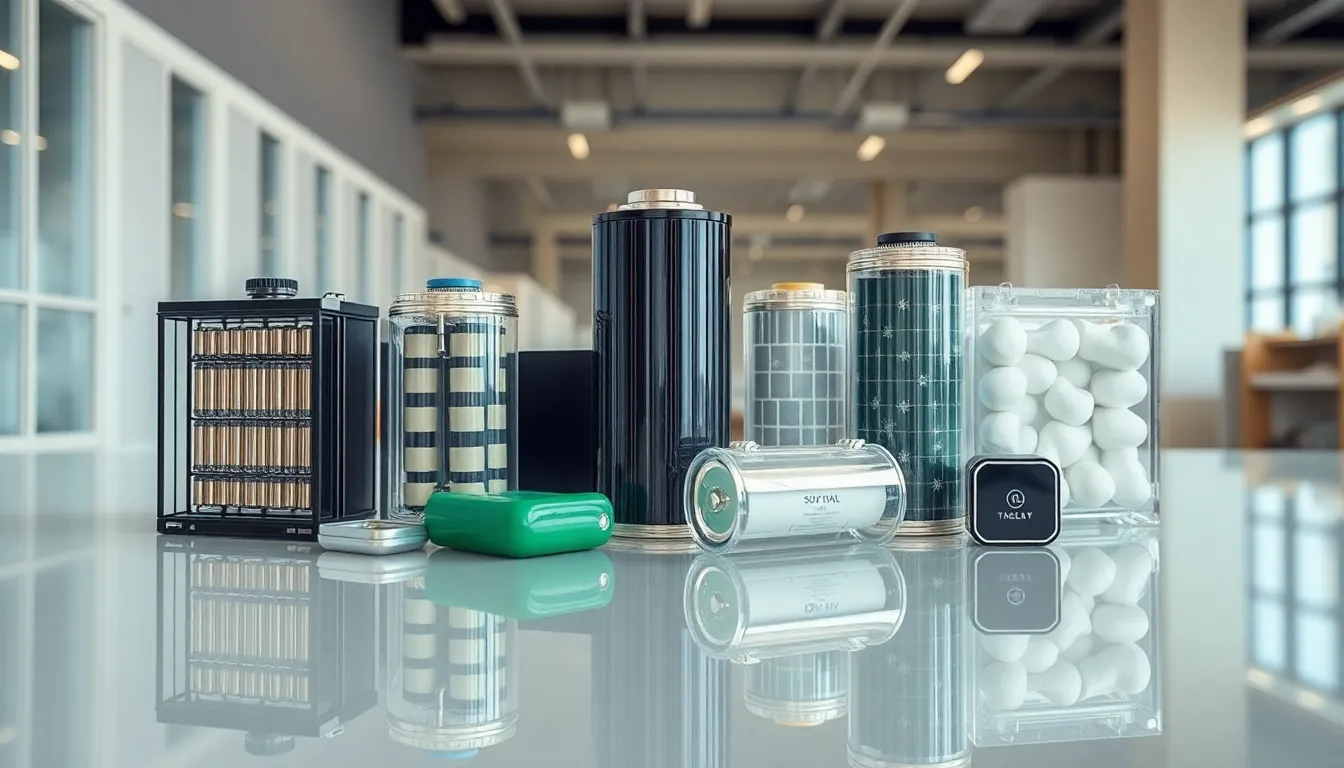Table of Contents
ToggleIn a world where phone batteries seem to drain faster than a toddler’s energy at bedtime, sustainable battery technology is stepping in like a superhero in a cape. Gone are the days of guilt-laden charging sessions and the dreaded “low battery” anxiety. With innovations that promise to keep our devices powered and the planet happy, this technology is the eco-friendly solution we’ve all been waiting for.
Overview of Sustainable Battery Technology
Sustainable battery technology focuses on developing battery systems that reduce environmental impact while enhancing performance. This technology prioritizes the use of renewable materials and environmentally friendly manufacturing processes.
Lithium-ion batteries lead the market but face challenges with resource extraction and recycling. Researchers are exploring alternatives, such as sodium-ion and solid-state batteries. Sodium-ion batteries utilize abundant materials and demonstrate potential for large-scale applications.
Solid-state batteries employ solid electrolytes instead of liquid ones. This shift enhances energy density and safety, reducing flammability risks. Companies like Toyota and QuantumScape invest heavily in this technology to accelerate its commercial viability.
Recycling plays a crucial role in sustainable battery development. Current processes often extract valuable materials like lithium and cobalt from used batteries. New methods aim to improve efficiency and reduce waste, making recycling a vital component in a circular economy.
Energy storage systems benefit from sustainable batteries as well. These systems support renewable energy integration by storing excess energy produced by solar or wind sources. Improved battery life and efficiency increase the feasibility of these applications.
Considering the urgent need for sustainable solutions, innovations in battery technology promote cleaner energy. By addressing concerns over environmental impact and resource scarcity, these advancements pave the way for a greener future in energy storage and consumption.
Types of Sustainable Batteries

Sustainable battery technology encompasses various types of batteries designed to minimize environmental impact. These innovations aim to improve energy efficiency while utilizing renewable materials.
Lithium-Ion Alternatives
Sodium-ion batteries represent a significant alternative to lithium-ion. Sodium’s abundance makes these batteries less reliant on scarce resources. Additionally, they offer comparable energy density. Researchers emphasize the potential for lower costs in production. Battery performance in diverse climates stands out, making sodium-ion a viable option for various applications. Furthermore, lithium-sulfur and lithium-air batteries provide enhanced energy capacity. Both promise increased range for electric vehicles and longer-lasting power for consumer electronics.
Solid-State Batteries
Solid-state batteries utilize solid electrolytes instead of liquid ones. Security remains a main advantage, with reduced risk of leaks or fires. Higher energy densities enable these batteries to pack more power into smaller sizes. Their longevity also surpasses that of conventional lithium-ion batteries. Manufacturers note that solid-state technology could lead to faster charging times. Consequently, these batteries present a promising option for electric vehicles and grid storage. Ongoing research aims to address manufacturing challenges and further enhance performance.
Environmental Impact of Battery Production
Battery production significantly affects the environment due to resource extraction and waste management challenges.
Resource Extraction Concerns
Resource extraction for batteries, including lithium, cobalt, and nickel, raises serious environmental concerns. Mining these minerals can lead to habitat destruction and water pollution. Many regions experience ecological damage alongside human rights issues linked to labor practices. In response, sustainable alternatives like sodium and potassium are being explored, as they are more abundant and cause less environmental disruption. Reducing reliance on scarce materials proves essential for mitigating the negative impacts of battery production.
Recycling and Second-Life Applications
Recycling plays a crucial role in decreasing the environmental impact of batteries. Effective recycling processes can recover up to 95% of valuable materials for reuse. Implementing efficient recycling methods reduces waste and supports a circular economy model. Additionally, second-life applications for batteries offer further sustainability, allowing used batteries to power energy storage systems or renewable energy sources. Finding innovative ways to repurpose old batteries promotes resource conservation and minimizes landfill contributions.
Innovations in Sustainable Battery Technology
Innovative advancements in sustainable battery technology are transforming energy storage solutions. Researchers focus on developing materials that reduce environmental impact while enhancing performance.
Advances in Materials
New materials play a vital role in sustainable battery technology. Sodium-ion batteries utilize abundant materials, offering a feasible alternative to traditional lithium-based systems. Natural resources such as seawater provide sodium, significantly reducing extraction challenges. Additionally, lithium-sulfur batteries leverage sulfur, a low-cost and widely available element. Solid-state batteries incorporate solid electrolytes, improving safety and longevity. Enhanced recyclability of these materials supports the shift toward a circular economy. Creative approaches to material sourcing contribute to minimizing ecological footprints, promoting responsible energy consumption.
Energy Density Improvements
Innovations in energy density are crucial for battery performance. Many researchers investigate lithium-sulfur batteries, which can achieve higher energy capacities compared to conventional lithium-ion counterparts. Efforts are underway to enhance energy retention in sodium-ion systems, making them competitive for various applications. Solid-state batteries also demonstrate significant potential, allowing larger energy storage in smaller packages. Increased energy density translates to extended usage times for devices and electric vehicles, empowering a more sustainable energy landscape. Overall, these improvements signal a promising future for efficient and environmentally friendly energy storage solutions.
Challenges Facing Sustainable Battery Technology
Sustainable battery technology faces several challenges that hinder its widespread adoption. These hurdles impact its efficiency and environmental benefits, making it crucial to address them.
Economic Barriers
Economic barriers significantly affect the development of sustainable battery technology. High production costs for alternative materials deter manufacturers from switching from traditional lithium-ion batteries. Innovations like sodium-ion batteries show promise, but initial investments in research and development remain substantial. Limited financial incentives exist for consumers to adopt greener options, often making it more economical to stick with familiar technologies. Price fluctuations in raw materials like cobalt and nickel create further instability in production costs. As a result, manufacturers and consumers can hesitate to transition to sustainable batteries without supportive policies or subsidies to lower entry costs.
Scalability Issues
Scalability issues also pose a challenge for sustainable battery technology adoption. While advancements in materials like solid-state electrolytes show potential, current production capacities cannot meet global demand. Manufacturing processes for alternative batteries often require extensive modifications to existing infrastructure, causing delays in widespread implementation. Research indicates significant advancements in energy density are possible, but scaling these innovations also takes time and resources. Furthermore, supply chains for abundant materials, such as sodium, may not be fully developed, limiting availability. Addressing these challenges is essential for ensuring that sustainable battery technologies can meet the world’s energy needs effectively.
The future of sustainable battery technology is bright and full of potential. As researchers continue to innovate and overcome existing challenges, the shift towards eco-friendly energy storage solutions will not only enhance device performance but also protect the environment. With alternatives like sodium-ion and solid-state batteries gaining traction, the industry is poised for transformation.
Emphasizing recycling and resource conservation will play a crucial role in this evolution. By embracing sustainable practices and materials, manufacturers can reduce their ecological footprint while meeting the growing demand for energy storage. The commitment to developing sustainable battery technology signifies a vital step toward a cleaner and more efficient energy landscape.




